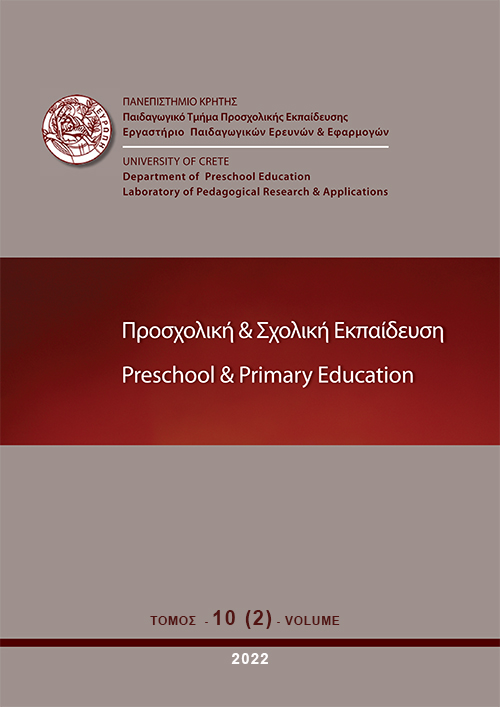Παράγοντες που ανάγονται σε επίπεδο σχολικής μονάδας και καθορίζουν την ενεργό συμμετοχή των μαθητών

Περίληψη
Η σχολική μονάδα ως περιβάλλον και πεδίο μάθησης μπορεί να διαφοροποιήσει την αλληλεπίδραση των μαθητών τόσο μεταξύ τους όσο και με τον εκπαιδευτικό, αλλά και να καθορίσει την ενεργό συμμετοχή τους στη διαδικασία μάθησης. Η σχολική μονάδα διέπεται από ποικίλους παράγοντες που αναφέρονται στον σχολικό χώρο και τα προσδιοριστικά του χαρακτηριστικά, στο παιδαγωγικό κλίμα με τις διαπροσωπικές σχέσεις που σε αυτό αναπτύσσονται, καθώς και στο επίσημο αναλυτικό πρόγραμμα που εφαρμόζεται. Λαμβάνοντας υπόψη λοιπόν τους παραπάνω παράγοντες, όπως προσδιορίζονται στη διεθνή βιβλιογραφία, κρίνουμε απαραίτητο να διερευνήσουμε τις απόψεις εν ενεργεία Ελλήνων εκπαιδευτικών αναφορικά με την επίδραση που οι ενδοσχολικοί παράγοντες ασκούν στην ενεργό συμμετοχή των μαθητών προσχολικής και πρώτης σχολικής ηλικίας. Για τον παραπάνω σκοπό πραγματοποιήσαμε ημιδομημένες ατομικές συνεντεύξεις σε δείγμα 95 εκπαιδευτικών πρωτοβάθμιας εκπαίδευσης. Για τον σχεδιασμό των συνεντεύξεων υιοθετήσαμε το μοντέλο οργάνωσης και λήψης συνέντευξης της Creswell (2008), ενώ για τη διεξαγωγή τους χρησιμοποιήσαμε οδηγό συνέντευξης με 198 ερωτήσεις ανοιχτού και κλειστού τύπου. Πρόκειται για μια διετή έρευνα που πραγματοποιήθηκε σε δύο φάσεις κατά τα διδακτικά έτη 2017-18 και 2019-2020. Τα αποτελέσματα από την ποσοτική και ποιοτική (επαγωγική ανάλυση δεδομένων) ανάλυση των δεδομένων δείχνουν ότι οι εκπαιδευτικοί του δείγματος αναγνωρίζουν ότι η σχολική μονάδα ως σύνολο ενδοσχολικών παραγόντων που τη διέπουν καθορίζει σημαντικά τα επίπεδα ενεργού συμμετοχής που οι μαθητές επιδεικνύουν. Οι συνεντευξιαζόμενοι, αν και προσδίδουν υψηλή σημαντικότητα στο παιδαγωγικό κλίμα και στο ανθρώπινο δυναμικό που στελεχώνει τη σχολική μονάδα, και ακολούθως στις κτιριακές υποδομές και το διαθέσιμο εποπτικό υλικό, αναγνωρίζουν ότι ο συνδυασμός των διάφορων ενδοσχολικών παραγόντων διαμορφώνουν εν τέλει την ενεργό συμμετοχή των μαθητών.
Λεπτομέρειες άρθρου
- Πώς να δημιουργήσετε Αναφορές
-
Τσιάρα Ε., Σακελλαριου Μ., Καλογιαννάκη Π., & Κόνσολας Ε. (2022). Παράγοντες που ανάγονται σε επίπεδο σχολικής μονάδας και καθορίζουν την ενεργό συμμετοχή των μαθητών. Preschool and Primary Education, 10(2), 239–257. https://doi.org/10.12681/ppej.28220
- Ενότητα
- Άρθρα

Αυτή η εργασία είναι αδειοδοτημένη υπό το CC Αναφορά Δημιουργού – Μη Εμπορική Χρήση – Παρόμοια Διανομή 4.0.
Οι συγγραφείς των άρθρων που δημοσιεύονται στο ΠΡΟΣΧΟΛΙΚΗ & ΣΧΟΛΙΚΗ ΕΚΠΑΙΔΕΥΣΗ διατηρούν τα δικαιώματα πνευματικής ιδιοκτησίας επί των άρθρων τους, δίνοντας στο περιοδικό το δικαίωμα της πρώτης δημοσίευσης. Άρθρα που δημοσιεύονται στο ΠΡΟΣΧΟΛΙΚΗ & ΣΧΟΛΙΚΗ ΕΚΠΑΙΔΕΥΣΗ διατίθενται με άδεια Creative Commons 3.0 και σύμφωνα με την άδεια μπορούν να χρησιμοποιούνται ελεύθερα, με αναφορά στο/στη συγγραφέα και στην πρώτη δημοσίευση για μη κερδοσκοπικούς σκοπούς και με δικαίωμα τροποποίησης μόνον με παρόμοια διανομή (αν αναμείξετε, τροποποιήσετε, ή δημιουργήσετε πάνω στο υλικό, πρέπει να διανείμετε τις δικές σας συνεισφορές υπό την ίδια άδεια όπως και το πρωτότυπο). To Εργαστήριο Παιδαγωγικών Ερευνών και Εφαρμογών του Παιδαγωγικού Τμήματος Προσχολικής Εκπαίδευσης του Πανεπιστημίου Κρήτης και το Εθνικό Κέντρο Τεκμηρίωσης διατηρούν το δικαίωμα να δημοσιεύουν, να αναπαραγάγουν, να παρουσιάζουν στο κοινό, να διανέμουν και χρησιμοποιούν άρθρα που δημοσιεύονται στο ΠΡΟΣΧΟΛΙΚΗ & ΣΧΟΛΙΚΗ ΕΚΠΑΙΔΕΥΣΗ σε οποιοδήποτε μέσο και μορφή είτε μεμονωμένα είτε ως μέρη συλλογικών έργων, για όλο το χρόνο διάρκειας προστασίας της πνευματικής ιδιοκτησίας και για όλες τις χώρες του κόσμου. Αυτό περιλαμβάνει ενδεικτικά και όχι αποκλειστικά, το δικαίωμα δημοσίευσης των άρθρων σε τεύχη του περιοδικού ΠΡΟΣΧΟΛΙΚΗ & ΣΧΟΛΙΚΗ ΕΚΠΑΙΔΕΥΣΗ, αναπαραγωγής και διανομής μεμονωμένων αντιγράφων των άρθρων, αναπαραγωγής ολόκληρων των άρθρων σε άλλη έκδοση του Εργαστηρίου Παιδαγωγικών Ερευνών και Εφαρμογών του Παιδαγωγικού Τμήματος Προσχολικής Εκπαίδευσης του Πανεπιστημίου Κρήτης και του Εθνικού Κέντρου Τεκμηρίωσης και αναπαραγωγής και διανομής των άρθρων ή περίληψης αυτών με χρήση πληροφορικού συστήματος αποθετηρίου.


